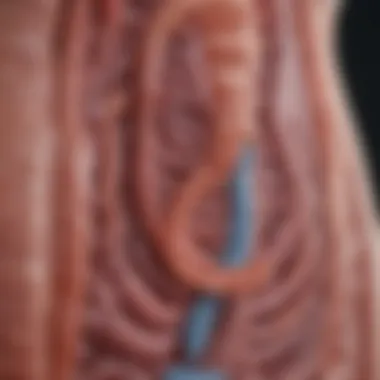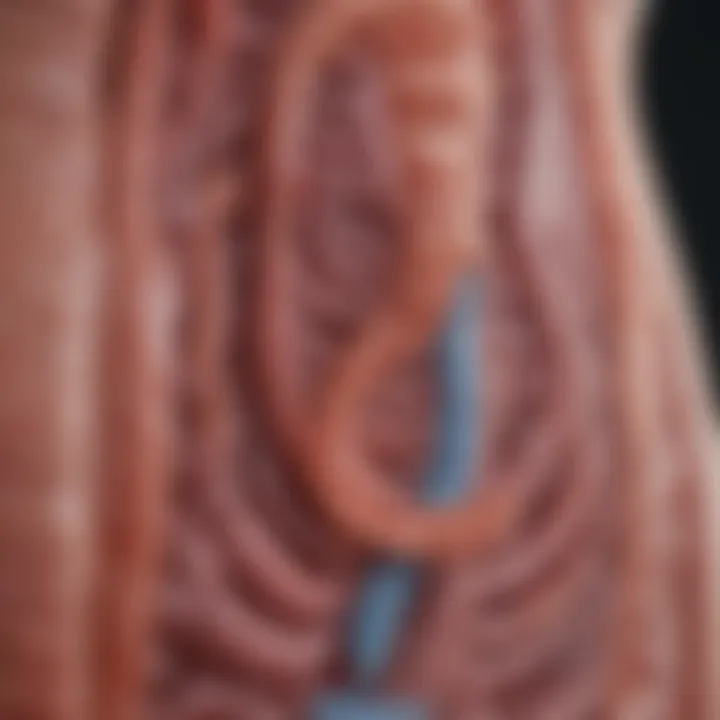Hydrogen Breath Test with Glucose: Mechanisms and Implications


Intro
The hydrogen breath test with glucose serves as a critical component in the landscape of gastrointestinal diagnostics. It offers a window into how our bodies process carbohydrates, particularly sugars, and how effectively our intestines absorb these vital nutrients. This test is not just a simple procedure but rather a diagnostic journey that uncovers various underlying issues related to carbohydrate metabolism and intestinal health.
Understanding the mechanisms at play during the hydrogen breath test is essential for both healthcare professionals and students pursuing studies in the biological sciences. This test measures the levels of hydrogen produced in the breath after ingestion of glucose, providing insights into how well the gastrointestinal tract is functioning. The relationship between glucose absorption and hydrogen production is key to diagnosing conditions like lactose intolerance and small intestinal bacterial overgrowth (SIBO). The accurate interpretation of these results can lead to better patient outcomes and more informed health decisions.
In the following sections, we will delve deeper into the mechanics of the hydrogen breath test, exploring its clinical significance, the biochemical implications of glucose in the testing process, and the practical aspects, including preparation and limitations. Together, these elements will paint a comprehensive picture of this indispensable tool in modern medicine.
Prelims
Understanding the hydrogen breath test with glucose is crucial for grasping how our bodies process carbohydrates. This test plays a significant role in diagnosing issues like malabsorption, which can lead to various gastrointestinal disorders. It helps clinicians to distinguish between normal and abnormal digestive pathways, offering insight that can be pivotal in improving patient outcomes.
The importance of this topic lies not just in the mechanics of the test itself but in the broader implications for gut health. As our society becomes increasingly aware of gastrointestinal health, this test sheds light on practices related to diet and overall wellness. With the rising popularity of low-carbohydrate diets, knowing how well the body absorbs these nutrients has never been more pressing.
More than just a diagnostic tool, the hydrogen breath test opens doors to understanding the intricate workings of our gut microbiome and its role in digestion. It highlights how simple sugars like glucose can influence hydrogen production, which serves as a marker for malabsorption conditions. As we delve deeper into the mechanisms and implications of the hydrogen breath test, it becomes clear that this tool is much more than a straightforward examination—it's a window into the complexities of human digestion.
Defining the Hydrogen Breath Test
The hydrogen breath test is quite straightforward in its execution yet complex in what it reveals. At its core, the test involves measuring the amount of hydrogen gas in the breath after a patient ingests a glucose solution. This approach hinges on the principle that certain carbohydrates are not fully absorbed in the small intestine. Instead, they make their way into the colon, where gut bacteria metabolize them, producing hydrogen as a byproduct.
When a person consumes glucose, if it’s not adequately absorbed, hydrogen will be produced and subsequently enter circulation, ultimately being expelled through the lungs. A breath sample taken after glucose ingestion can reveal the concentration of hydrogen. Greater levels of hydrogen than expected indicate potential malabsorption issues, hinting at conditions such as small intestinal bacterial overgrowth.
Significance of Glucose in the Test
Glucose is more than just a sweet substance—it is a critical player in understanding digestive health. The choice of glucose as the substrate for the breath test stems from its simplicity and widespread absorption patterns. Typically, glucose is efficiently absorbed in a healthy intestine. If malabsorption occurs, glucose serves as a reliable marker for gastrointestinal dysfunction.
When glucose is ingested during the test, it challenges the body's absorptive capabilities. The subsequent production of hydrogen is monitored and measured over intervals, providing diagnostic clues. This process emphasises the importance of glucose not merely as a source of energy but also as an essential tool in revealing underlying digestive or metabolic disorders.
To summarize, the hydrogen breath test with glucose is a pivotal step in diagnostics. It reveals not just a snapshot of carbohydrate absorption but also tells a deeper story about our gut health and the efficacy of our digestive systems.
Scientific Principles of the Hydrogen Breath Test
Understanding the scientific principles of the hydrogen breath test is fundamental for comprehending its utility in diagnosing gastrointestinal conditions. This section elucidates the biochemical and biological underpinnings that facilitate the assessment of carbohydrate malabsorption. The core of this diagnostic tool relies on the interaction between glucose, gut microbiota, and metabolic processes, presenting a complex yet insightful narrative.
Mechanism of Hydrogen Production
At the heart of the hydrogen breath test is the mechanism that catalyzes hydrogen production within the intestines. When glucose—an easily fermentable carbohydrate—is ingested, it enters the small intestine where it undergoes absorption. However, in the case of malabsorption syndromes, glucose fails to absorb effectively.
As glucose travels into the colon undigested, the resident gut bacteria seize the opportunity. These microorganisms ferment the glucose, leading to the production of hydrogen gas. This gas is then absorbed through the intestinal wall into the bloodstream, eventually reaching the lungs where it is expelled through exhalation. The concentration of hydrogen in the breath samples reflects the extent of fermentation and indirectly signals the absorption capacity of the intestine.
The key takeaway here is that higher levels of hydrogen in the breath indicate poor absorption of glucose, while normal levels suggest that the carbohydrate is being adequately absorbed in the upper gastrointestinal tract. This simple yet powerful reaction serves as a linchpin in diagnosing various digestive disorders.
Role of Gut Microbiota
The gut microbiota plays a pivotal role in the dynamics of the hydrogen breath test. Essentially, these bacteria influence how carbohydrates like glucose are processed within the intestines. The diversity and composition of gut flora vary greatly among individuals, affecting not just digestion but also overall health outcomes.
For instance, a balanced gut microbiome can efficiently ferment carbohydrates, producing beneficial short-chain fatty acids. Conversely, an imbalance—often termed dysbiosis—can lead to excessive hydrogen production or altered metabolic pathways, contributing to symptoms like bloating and abdominal pain.
Research indicates that the presence of certain bacterial species can enhance or impair the fermentation of glucose. Hence, an individual’s microbiotal profile could direct the interpretation of breath test results. Understanding this relationship enriches our comprehension of not just the hydrogen breath test itself but also opens avenues for personalized medicine based on one's unique microbial composition.
Important Insight: Understanding that gut microbiota influences glucose fermentation not only helps in interpreting breath test outcomes but also highlights potential strategies for therapeutic interventions through dietary changes or probiotics.


Test Procedure
Understanding the test procedure is the backbone of the hydrogen breath test with glucose. It provides a structured roadmap to ensure that the test yields accurate and reliable results. Poor adherence to procedure can taint the results, leading to misinterpretations that could skew clinical assessments and procedures that follow. In this sense, the test procedure isn't merely procedural; it’s foundational for robust gastrointestinal diagnostics.
Preparation for the Test
Preparing for the hydrogen breath test requires strategic planning to ensure accurate readings. From dietary restrictions to fasting guidelines, each element plays a crucial role.
Dietary Restrictions
Dietary restrictions prior to testing are vital in eliminating interference caused by foods that produce hydrogen. Specific guidelines often suggest avoiding high-fiber foods like beans or whole grains, since these can significantly impact the test outcomes. It’s a crucial aspect because the goal is to solely measure the body's response to glucose without competing derivatives from previous meals.
The core of dietary restrictions lies in their simplicity. Patients typically follow a bland diet for a couple of days before the test, which filters out potential confounding variables. While there may be variations, avoiding certain foods serves as a practical way to enhance the accuracy of results. However, this measure can also be a double-edged sword; some individuals may find these restrictions challenging or cumbersome, particularly if they are accustomed to a more varied diet.
Fasting Guidelines
Fasting guidelines are equally important. They generally require individuals to refrain from all food and drink for at least 8 hours before the test. This abstinence allows the gastrointestinal tract to return to a baseline state, enhancing the reliability of the findings and minimizing background hydrogen from undigested food.
The fasting period also offers an invaluable opportunity for practitioners to discuss the rationale behind it, potentially increasing patient compliance. However, variations can exist. Some people may experience discomfort during prolonged fasting, particularly if they have a history of gastrointestinal issues. This discomfort could affect their overall willingness to undergo the test, making communication about the importance of fasting essential.
Administering the Test
Administering the test then follows preparation, which includes the timing of sample collection and the analysis of breath samples.
Sample Collection Timing
Timing for sample collection is essential to capturing accurate hydrogen levels. After ingesting glucose, breath samples are taken at specific intervals—usually every 15 to 30 minutes for two hours. This timing serves as a methodological approach to track the precise moment when hydrogen levels peak, which indicates a fermentation process taking place in the gut.
This planning makes sample collection more systematic and less arbitrary, improving the test's diagnostic accuracy. However, it can also present logistical challenges. Patients must adhere strictly to this timeframe to reduce the possibility of anomalies in results, which can feel stressful and rushed.
Breath Sample Analysis
Once samples have been collected according to set intervals, breath sample analysis becomes the focal point. This phase entails measuring the concentration of hydrogen in the samples using gas chromatography. The key characteristic of breath sample analysis is its non-invasiveness and quick turnaround time for results—these features contribute to its growing popularity in clinical settings.
However, there are distinct advantages and downsides. While easy to administer, the technical aspect of analysis requires specialized equipment and well-trained personnel. Missteps in analysis can lead to inaccurate results, thus overshadowing the importance of the earlier collection steps.
The intricacies of test procedure shape the narrative of the hydrogen breath test. A thorough understanding of how preparation, administration, and analysis interact enhances the overall clarity and accuracy of the diagnostic process. By examining these facets, the relevance of each component becomes evident in the larger conversation about gastrointestinal health.
Overall, the meticulous execution of the test procedure is crucial for valid results and effective diagnosis.
Interpreting Test Results
Understanding how to interpret the results of a hydrogen breath test with glucose is crucial for diagnosing and managing gastrointestinal disorders. This part of the article will clarify what the different test outcomes mean and highlight why these interpretations hold significant value for both patients and healthcare professionals.
Normal vs. Abnormal Results
When undergoing the hydrogen breath test, the results can fall into two categories: normal and abnormal. Understanding this differentiation can enlighten treatment strategies and patient management.
Normal Results
Normal hydrogen levels after glucose ingestion generally indicate effective carbohydrate absorption. A typical post-prandial increase in hydrogen is expected to be within a specific range, reflecting a healthy intestine that processes glucose properly.
- Normal rise in hydrogen may suggest:
- Effective gut function
- Normal absorption capacity


Abnormal Results
Conversely, an abnormal rise in hydrogen levels can suggest possible malabsorption or other underlying conditions. For instance, significant elevations of hydrogen after glucose ingestion might indicate:
- Lactose intolerance: If a patient has an elevated hydrogen level when lactose is consumed along with glucose, it suggests that the gut is reacting negatively to lactose.
- Small Intestinal Bacterial Overgrowth (SIBO): Unusually high hydrogen levels could point towards an excess of bacteria in the small intestine, which ferment glucose improperly, resulting in excessive gas.
- Intestinal Disorders: Conditions such as celiac disease or gluten intolerance may also show irregular patterns in hydrogen production and retention.
Understanding these results can help tailor further diagnostic procedures or treatments, making it essential for caregivers and patients alike to grasp these differences.
Clinical Relevance of Hydrogen Levels
The levels recorded during a hydrogen breath test with glucose can provide vital insights into a patient's overall gut health.
Significance of Hydrogen Levels
The measurement of hydrogen present in the breath is not just a numerical figure; it signifies biological processes occurring in the digestive system. Elevated hydrogen levels can be significant for:
- Guiding treatment options: For example, recognizing SIBO can lead to the prescription of appropriate antibiotics or dietary changes to mitigate symptoms.
- Monitoring chronic conditions: Patients with known digestive issues may rely on hydrogen levels to monitor their health status over time, guiding adjustments in medication or lifestyle.
- Research implications: Hydrogen levels can offer deeper understanding in the context of studies related to gastrointestinal health. It can reflect how diet influences microbial communities in the gut or how gut health affects overall wellness.
Key Takeaway: Accurately interpreting the hydrogen levels from breath tests can lead to effective management of gastrointestinal health and contributes significantly to patient care strategies.
Clinical Applications
The hydrogen breath test with glucose plays a profound role in understanding various gastrointestinal conditions. It is not just a method for gauging carbohydrate malabsorption; it also offers insights into the broader scope of intestinal health. As medical research continues to evolve, recognizing these clinical applications becomes essential for both diagnostics and patient management.
Diagnosing Malabsorption Syndromes
Diagnosing malabsorption syndromes can be a tricky endeavor. These conditions, where the body fails to absorb certain nutrients adequately, often lead to a host of symptoms including diarrhea, weight loss, and nutritional deficiencies. The hydrogen breath test is a valuable tool in this diagnostic process. When glucose is ingested, the body should absorb it in the small intestine. If malabsorption occurs, unabsorbed glucose travels to the colon where it ferments, producing hydrogen. The test is effective as it pinpoints the dysfunction in carbohydrate absorption.
The results from this test can lead to crucial insights. If the hydrogen levels in the breath are notably elevated, it may indicate a primary malabsorption issue such as that seen in conditions like celiac disease or chronic pancreatitis. Thus, the test not only helps confirm suspicions but also guides further investigative pathways. It can provide actionable information that healthcare professionals can use to tailor individualized treatment plans.
Implications for Irritable Bowel Syndrome
Irritable Bowel Syndrome (IBS) is a common disorder affecting the large intestine, characterized by recurring abdominal pain, gas, and altered bowel habits. The connection between hydrogen production and gut health offers profound implications for understanding and managing IBS. Some individuals with IBS exhibit a unique reaction to certain carbohydrates that are otherwise fermented during the hydrogen breath test.
When glucose is consumed, individuals sensitive to such carbohydrates may experience a surge in hydrogen. This may lead clinicians to suspect that a form of restrictive diet could be beneficial for those patients. The low FODMAP diet, for instance, frequently helps reduce symptoms in IBS patients. More so, employing the hydrogen breath test as a diagnostic tool helps clinicians evaluate how patients react to various carbohydrates - providing insight that can be pivotal in managing symptoms. In doing so, they can adjust dietary recommendations and therapies in a personalized manner.
Role in Identifying Small Intestinal Bacterial Overgrowth (SIBO)
Small Intestinal Bacterial Overgrowth (SIBO) refers to an abnormal increase in the bacterial population in the small intestine. These bacteria can metabolize carbohydrates prematurely, leading to gas production and discomfort. The hydrogen breath test with glucose has emerged as a prominent method for diagnosing SIBO. As glucose reaches the small intestine, if bacteria overgrowth is present, hydrogen is produced quickly, and this can be detected in the breath.
Unlike other diagnostic methods, including stool tests or scintigraphy, the hydrogen breath test is non-invasive. It's often preferred for its straightforward nature. Elevated hydrogen levels after glucose intake indicate that bacteria are fermenting this substrate, confirming the presence of SIBO. Ultimately, this allows for the timely identification and management of the condition, which can be crucial for preventing more severe gastrointestinal complications down the line.
The utility of the hydrogen breath test extends beyond diagnostics; it opens avenues for tailored treatment approaches and enhanced patient outcomes.
In summary, the clinical applications of the hydrogen breath test with glucose are vast. From diagnosing malabsorption syndromes and evaluating IBS implications to identifying SIBO, it serves as a vital resource in contemporary medical practice. This depth of analysis not only enhances understanding but also directly contributes to improving patient care strategies.
Limitations of the Test
Understanding the limitations of the hydrogen breath test with glucose is essential for professionals and enthusiasts who wish to garner a comprehensive view of its utility and constraints. While this test serves as an invaluable tool for diagnosing gastrointestinal disorders, it is not infallible. Recognizing these limitations allows medical practitioners to interpret results judiciously and pursue further diagnostic avenues when necessary.
Potential for False Positives and Negatives
A major concern surrounding the hydrogen breath test is the potential for false positives and negatives, which can mislead both patients and providers. False positives may occur when the test indicates a problem with carbohydrate absorption, despite the absence of any clinical issues. For instance, factors like a high-fiber diet in the days leading up to the test could potentially skew results, leading to inaccurate interpretations.
Conversely, false negatives can also be a significant problem. These might arise if the test is taken too soon after consuming glucose or if the individual has an atypical gut environment. A patient might feel assured that everything is functioning well, only to remain undiagnosed when there is an underlying condition.


In essence, while the test is useful, its results must be viewed in conjunction with clinical judgment and other diagnostic tools to establish an accurate picture of gastrointestinal health.
Factors Influencing Results
Several factors can influence the results of the hydrogen breath test, leading to varying degrees of accuracy. Here we examine some critical aspects.
Medications
The impact of medications on test outcomes cannot be underestimated. Certain drugs, especially antibiotics, can significantly alter gut microbiota. This alteration might lead to decreased hydrogen production and, consequently, misleading test results. For example, taking antibiotics immediately before the test may suppress the presence of bacteria that typically aid in carbohydrate digestion, yielding a false-negative result.
Additionally, proton pump inhibitors, commonly prescribed for acid reflux, can affect stomach acid levels and thus alter the fermentation dynamics within the gut. This variable can mask underlying conditions relevant to carbohydrate absorption. Therefore, when a patient is on specific medication regimens, it is crucial to factor this into the interpretation of hydrogen breath tests to avoid misdiagnoses.
Dietary Interference
Dietary choices leading up to the hydrogen breath test can heavily sway the results. High-fiber foods consumed shortly before the test can exaggerate hydrogen production, possibly indicating malabsorption when there is none. A patient who indulges in foods rich in oligosaccharides might inadvertently distress their digestive system prior to the test, falsely suggesting issues with glucose absorption.
Moreover, the timing of the last meal can also play a role. Consuming a heavy meal right before the test may lead to erratic hydrogen levels, which complicates the understanding of one's metabolic state. Therefore, adhering to pre-test dietary restrictions isn't just a suggestion; it's a critical element of ensuring the test's validity.
Future Directions in Research
Research into the hydrogen breath test with glucose holds significant promise for the advancement of gastrointestinal diagnostics and treatment. This section focuses on the evolving landscape of this area, particularly emphasizing the advancements in technology and the exploration of alternative substrates. Both topics play a pivotal role in enhancing the accuracy, efficiency, and utility of the hydrogen breath test in clinical settings.
Advancements in Breath Testing Technology
As technology scurries forward, the field of breath testing is no exception. Significant advancements have been noted in the sensitivity and specificity of the devices used to measure hydrogen and methane levels. Traditionally, these tests relied on bulky equipment and lengthy procedures that required significant patient cooperation. Recent innovations, however, have introduced:
- Portable Breath Analyzers: Smaller, more user-friendly devices have made breath testing tests possible in outpatient settings. This ensures less time in clinics for patients and potentially quicker results.
- Real-time Data Analysis: New analytical software allows for instantaneous data collection and interpretation, reducing the waiting time for results. It integrates mobile applications, enabling patients to track their own symptoms correlated with their breath tests.
- Enhanced Detection Methods: Recently developed sensors can reportedly detect lower concentrations of hydrogen and methane, which could help uncover more subtle cases of malabsorption or SIBO, thus enhancing overall diagnostic accuracy.
These advancements not only foster a deeper understanding of the conditions being studied but also create new avenues for patient treatment, enhancing their overall experience and outcomes.
Exploration of Alternative Substrates
While glucose has been the gold standard for hydrogen breath tests, researchers are beginning to examine other substrates that might better reflect various carbohydrate malabsorption scenarios. The investigation into alternatives such as lactose, fructose, and even resistant starch could unveil new insights on gastrointestinal conditions. The implications of this exploration are twofold:
- Broader Application: Different substrates can help identify specific malabsorption issues tied to carbohydrates consumed in typical diets. For example, fructose malabsorption is increasingly recognized as a common issue that standard glucose tests may overlook.
- Individualized Treatments: Successful identification of malabsorption through various substrates can lead to more tailored dietary interventions. Some patients may respond better to certain types of carbohydrates, and understanding this can greatly improve their quality of life.
"The future of breath testing lies in understanding individual differences in metabolism. It's not one-size-fits-all anymore, and that’s exciting!"
In summary, the future of hydrogen breath testing with glucose is bright, marked by advancements in technology and the exploration of a variety of substrates. These developments will not only enhance diagnostic proficiency but also open the door to innovations in treatment for gastrointestinal disorders, improving patient care on multiple fronts.
Closure
The conclusion serves as the linchpin of this article, tying together the various threads of discussion surrounding the hydrogen breath test with glucose. It's vital to recap how this diagnostic tool operates, highlighting its utility in unveiling underlying gastrointestinal issues. Takeaways from our elaboration touch on not just the mechanics of how hydrogen is produced in response to glucose ingestion but also the broader implications for patient care.
Summary of Key Points
- Mechanism at Work: The hydrogen breath test primarily measures hydrogen production after glucose intake, revealing insights into carbohydrate absorption.
- Role in Diagnostics: It's pivotal in diagnosing conditions like carbohydrate malabsorption, irritable bowel syndrome, and small intestinal bacterial overgrowth (SIBO).
- Limitations Considered: Potential pitfalls such as false positives or negatives cannot be ignored, emphasizing the need for comprehensive interpretation against clinical signs.
- Future Prospects: As technology advances, so do the possibilities for enhancing breath testing methods and exploring other substrates beyond glucose.
These points aren’t merely academic; they have real-world implications for patient diagnostics and treatment pathways.
Importance for Clinical Practice
The importance of understanding the hydrogen breath test cannot be overstated. For clinicians, it provides a non-invasive method to assess gastrointestinal health, guiding treatment decisions and improving patient outcomes. Educators and researchers can leverage this knowledge to push forward in clinical studies, exploring the nuances of how gut health affects overall bodily functions.
“With the right tools, we can demystify many gastrointestinal disorders that ail patients today.”
As practitioners make clinical decisions informed by breath test results, better targeting of therapies becomes achievable. Additionally, it opens a dialogue between health professionals and patients, enabling informed consent and shared decision-making regarding treatment options.
In summary, the hydrogen breath test with glucose is not just a test; it’s a gateway to understanding health on a deeper level, illuminating avenues for research and improving health outcomes in practice.







